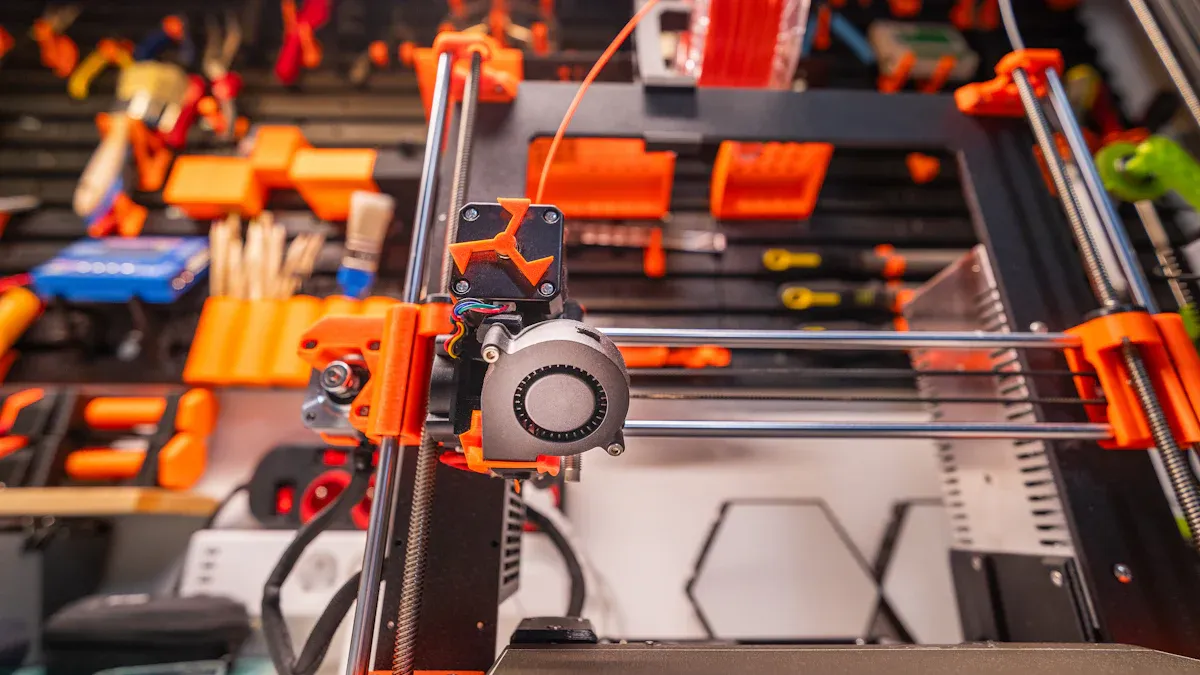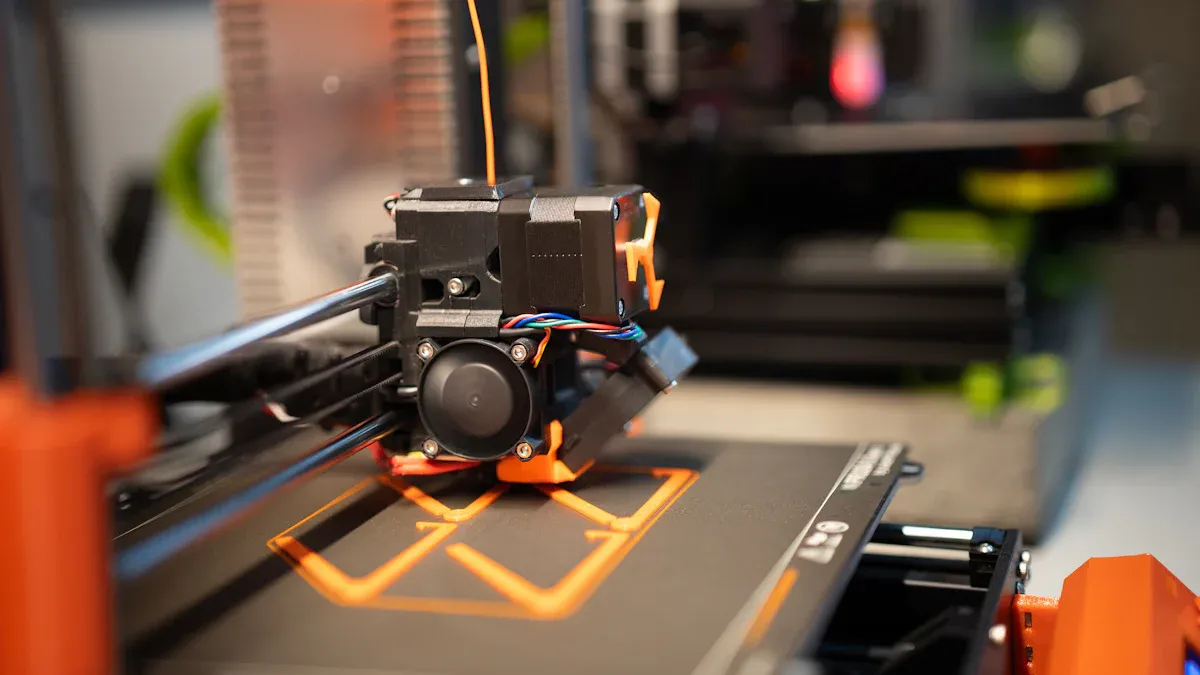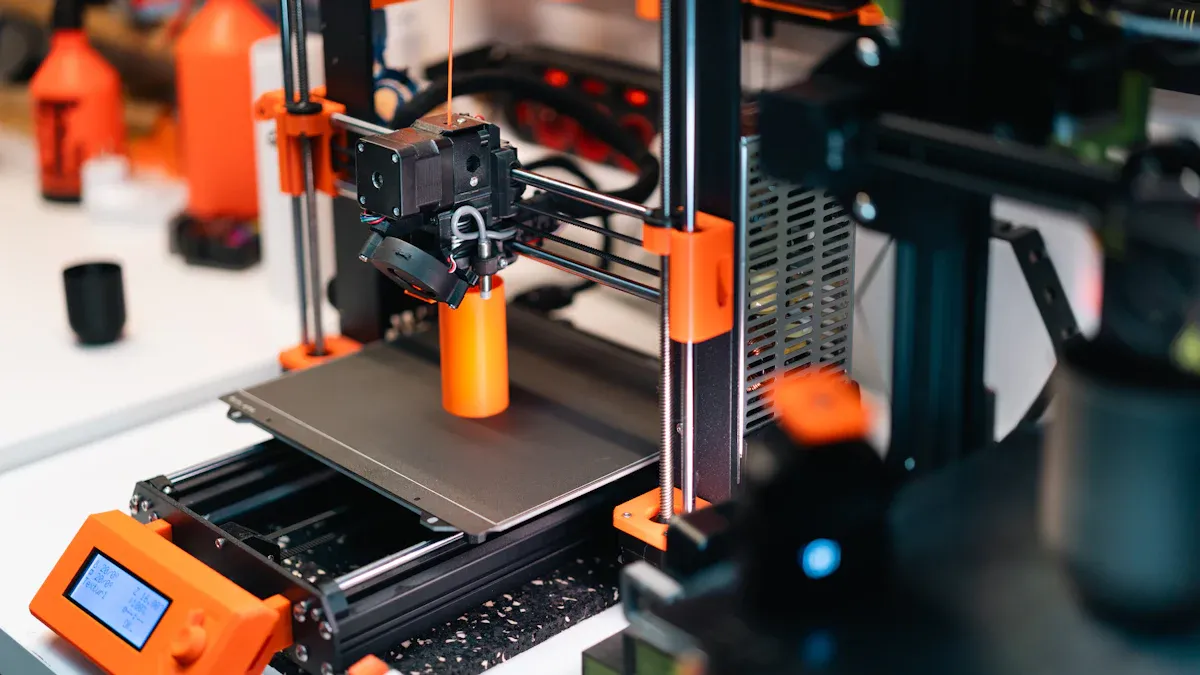
Choosing the right prototyping method can make or break your project. Around 70% of prototypes fail during assembly, often due to poor method selection. Injection molding and additive manufacturing offer distinct advantages, but each suits different needs. For instance, additive manufacturing excels in flexibility, while injection molding supports high-volume production. The rapid prototyping market, valued at $2.5 billion in 2021, is expected to reach $15 billion by 2031. This growth highlights the importance of cost-effective and fast methods. By selecting wisely, you can reduce costs, speed up development, and explore complex designs with ease.
Injection molding is a manufacturing process that creates parts by injecting molten material into a mold. This method is widely used for producing prototypes and high-volume parts. The process follows a structured workflow to ensure precision and efficiency:
This process ensures that injection molded parts meet strict quality standards, making it ideal for industries like automotive, medical devices, and aerospace.
Prototype injection molding offers several advantages for rapid prototyping. It delivers unmatched precision, achieving tolerances as fine as IT7, which is superior to most other methods. Advanced CAD/CAM software allows you to quickly iterate designs, ensuring functional prototypes are ready in less time.
This method is also highly efficient. You can produce the first part within 2-4 weeks, which is faster than many other techniques. For medium to high-volume production, prototype injection molds become cost-effective. Multi-cavity molds and materials like aluminum further reduce costs.
Injection molding minimizes material waste by injecting only the required amount of plastic. This is especially important for industries like medical devices, where numerous prototypes are needed. Additionally, automated systems ensure consistent quality, even for complex designs.
If you need hundreds or thousands of parts, prototype injection molding is the best choice. It provides consistent dimensions and functionality, making it perfect for testing and presentations. As production scales, the per-unit cost drops significantly, offering a cost-effective solution compared to traditional injection molds or CNC machining.
Additive manufacturing, commonly known as 3D printing, builds objects layer by layer using digital designs. Unlike traditional methods that remove material, this process adds material only where needed. You start by creating a 3D model using CAD software. The design is then converted into a file format like STL, which guides the printer.
The printer uses materials such as plastics, metals, or composites. It deposits these materials layer by layer, fusing them through heat, light, or binding agents. This method allows you to create intricate shapes that are difficult or impossible to achieve with other manufacturing technology.
Technological advancements have significantly improved additive manufacturing. Faster printing speeds and multi-material systems now make it more efficient and versatile. These innovations have expanded its use in prototyping applications, especially in industries like automotive and aerospace.
Did you know? The additive manufacturing market is projected to reach $17.58 billion in 2023, with prototyping accounting for over 54% of the revenue share in 2022. This highlights its critical role in rapid prototyping and design development.
Prototyping with additive manufacturing offers numerous advantages. It allows you to test functionality and design before committing to mass production. This saves time and money by enabling changes early in the process. You can also create 3D-printed prototypes with complex geometries that traditional methods cannot achieve.
This method generates minimal waste, making it more energy-efficient and environmentally friendly. On-demand production reduces inventory costs and streamlines the entire process. For small production runs, additive manufacturing eliminates setup costs, making it highly cost-effective.
You can also iterate designs quickly, leading to faster development cycles. Industries like medical devices and aerospace benefit from its precision and ability to produce custom parts. By using 3D printing, you reduce errors and improve accuracy, ensuring prototypes meet exact specifications.
Tip: Additive manufacturing is ideal for rapid prototyping when you need flexibility, speed, and cost savings. It’s a game-changer for creating innovative designs and testing them efficiently.

When comparing costs, injection molding and additive manufacturing differ significantly based on production volume and design changes. Injection molding involves higher upfront costs due to tooling, but it becomes more economical as production scales. Additive manufacturing, often referred to as 3D printing, offers lower initial costs, making it ideal for small production runs or custom designs.
| Factor | Injection Molding Cost | 3D Printing Cost |
|---|---|---|
| Break-even Point | 250 to 2,000 parts | 250 to 2,000 parts |
| Cost for 20,000 parts | Higher | 10% to 20% less |
| Cost for 40,000-50,000 parts | On par | On par |
| Tooling Costs | Higher for design changes | Lower for design changes |
For large-scale production, injection molding offers better cost-effectiveness. However, if you need frequent design changes or small batches, additive manufacturing provides greater flexibility and lower costs. This makes it a preferred choice for rapid prototyping and customization.
Speed plays a critical role in rapid prototyping. Injection molding requires time to create molds, which can take weeks. Once the mold is ready, production speeds up, allowing thousands of parts to be produced daily. This makes it suitable for high-volume production.
Additive manufacturing, on the other hand, eliminates the need for molds. You can start producing parts immediately after finalizing the design. This significantly reduces lead times, especially for small batches or custom designs. However, the layer-by-layer process of 3D printing can be slower for large quantities.
If you prioritize rapid turnaround for small runs or unique designs, additive manufacturing is the faster option. For mass production, injection molding delivers unmatched efficiency.
The materials available for injection molding and additive manufacturing differ in type and application. Injection molding supports a wide range of materials, including thermoplastics, thermosets, and elastomers. These materials offer excellent durability and are suitable for industries like automotive and aerospace.
Additive manufacturing also provides diverse material options, such as plastics, metals, and composites. However, it excels in offering materials tailored for specific applications. For example:
| Process | Material Type | Key Characteristics |
|---|---|---|
| Injection Molding | Maraging Steel | Easy to 3D print but prone to corrosion, limiting its effectiveness for conformal cooling applications. |
| Additive Manufacturing | Corrosion Resistant Tool Steels | Better suited for mold inserts with internal channels, enhancing cooling efficiency. |
| Additive Manufacturing | Ceramic Mold Solutions | Allows for rapid design iterations and onshoring of mold development, addressing tariff concerns. |
Injection molding offers a broader range of materials for high-volume production. Additive manufacturing, however, provides unique materials that enable customization and innovation. This makes it a powerful tool for creating custom designs and prototypes.
When it comes to production volume, injection molding and additive manufacturing serve different purposes. Injection molding excels in high-volume production. Once the mold is created, you can produce thousands or even millions of parts with consistent quality. This makes it ideal for industries that require mass production, such as automotive or consumer goods.
For example, producing 5,000 units of a custom enclosure using injection molding costs around $2 per unit with a 12-week timeline. This method ensures cost reduction at scale, making it the go-to choice for large production runs.
Additive manufacturing, on the other hand, is better suited for low to medium production volumes. It eliminates the need for tooling, allowing you to start production immediately. This is particularly useful for small batches or when you need to test a product in the market. For instance, creating 100 units of a phone stand using 3D printing costs $25 per unit with a 2-week timeline. This approach enables fast market testing and easy design changes.
If your project requires rapid prototyping or high customization, additive manufacturing offers unmatched flexibility. However, for large-scale production, injection molding remains the most cost-effective option.
Design flexibility is where additive manufacturing truly shines. With 3D printing, you can create complex geometries that are impossible to achieve with traditional methods. Internal features, intricate patterns, and variable wall thicknesses are all within reach. This level of design freedom allows you to innovate without worrying about tooling limitations.
Injection molding, while precise, has stricter design constraints. Features like uniform wall thickness and draft angles are necessary to ensure proper mold filling and part removal. For example, wall thickness in injection molding must remain uniform within a ±10% variation, typically ranging from 1.2 to 3 mm. In contrast, 3D printing allows variable wall thicknesses from 0.8 to 20 mm.
| Design Feature | Injection Molding | 3D Printing | Design Impact |
|---|---|---|---|
| Wall Thickness | Must be uniform (±10%) | Variable allowed | Affects part strength, cooling, and warpage |
| Draft Angles | Required (1-3° minimum) | Not required | Impacts part removal and surface finish |
| Internal Features | Limited by tooling | Highly flexible | Affects functionality and assembly options |
| Design Changes | Expensive (new tooling) | Quick and low-cost | Critical for iterative development |
If you need to iterate designs quickly or create prototypes with intricate details, additive manufacturing is the better choice. However, injection molding provides a higher quality surface finish and is more suitable for production quality parts.
The quality and durability of parts depend on the manufacturing method and material used. Injection molding produces parts with excellent mechanical properties and a higher quality surface finish. This makes it ideal for industries like aerospace and medical devices, where precision and durability are critical.
Additive manufacturing also delivers high-quality parts, but the layer-by-layer process can sometimes result in visible layer lines. While this may not affect functionality, it can impact the aesthetic appeal of the part. However, advancements in 3D printing technology have significantly improved surface finishes and material strength.
For example, injection molding uses materials like thermoplastics and elastomers, which offer superior durability. Additive manufacturing, on the other hand, provides unique materials such as corrosion-resistant tool steels and ceramic mold solutions. These materials enable high customization and innovative designs.
If you prioritize durability and a polished finish, injection molding is the better option. For rapid prototyping or when you need easy design changes, additive manufacturing provides the flexibility you need.
Injection molding offers several advantages for prototyping and production. It produces parts with consistent quality and excellent surface finishes. This method works well for high-volume production, as the cost per part decreases significantly with larger quantities. The wide range of materials available ensures durability and suitability for various industries, including automotive and medical devices.
However, injection molding has its disadvantages. The upfront cost for tooling is high, making it less suitable for small production runs. Design changes can also be expensive, as they require new molds. The process has limitations in creating complex geometries, as uniform wall thickness and draft angles are necessary for proper mold filling and part removal.
Tip: If you need thousands of parts with consistent quality, injection molding is a cost-effective choice.
Additive manufacturing, or 3D printing, excels in flexibility and innovation. It allows you to create complex designs that traditional methods cannot achieve. You can consolidate multiple parts into a single unit, reducing assembly time. On-demand manufacturing shortens lead times, making it ideal for rapid prototyping.
Despite its strengths, additive manufacturing has disadvantages. Post-processing can be time-consuming, especially for parts requiring a smooth finish. The process may also lack consistency, as unsteady operations can affect production efficiency. For large-scale production, additive manufacturing becomes less cost-effective compared to injection molding.
Did you know? Additive manufacturing enables you to test designs quickly, saving time and resources during product development.
Both methods have unique advantages and disadvantages. Your choice depends on factors like production volume, design complexity, and budget.
Choosing between injection molding and additive manufacturing depends on several factors. These include your budget, the production volume, and the complexity of your design. Each method has unique strengths that align with specific project requirements.
Tip: Use a decision-making framework, such as the Pythagorean fuzzy CRITIC and EDAS methods, to evaluate these factors objectively. These frameworks weigh criteria like cost, speed, and material suitability, helping you make an informed choice.
Prototype injection molding is most advantageous when you need high-quality parts for testing or presentations. It works well for low to mid-volume production, especially when durability and surface finish are critical.
Note: Material costs can vary. For instance, ABS costs around $1.3 per pound, while PC costs $2.3 per pound. Consider these factors when planning your budget.
Additive manufacturing is ideal for rapid prototyping and projects requiring high design flexibility. It allows you to create complex geometries and iterate designs quickly.
Did you know? Additive manufacturing complements traditional methods by enhancing prototyping speed and enabling hybrid processes. It also allows manufacturers to adjust production capacity quickly, meeting fluctuating market demands.

Combining injection molding and additive manufacturing can enhance your prototyping workflow. These methods complement each other by leveraging their unique strengths. Additive manufacturing allows you to quickly create intricate designs and test multiple iterations. Once you finalize the design, injection molding ensures high-quality, durable prototypes for functional testing or presentations.
For example, additive manufacturing can produce customized inserts for molds, enabling rapid design changes. This hybrid approach reduces costs by up to 90% for mold inserts while maintaining flexibility. A case study on over-molding with Technomelt-PA 7846 black demonstrated how hybrid mold fabrication improves efficiency. Additionally, customized inserts can be swapped out quickly to meet specific customer needs.
| Key Findings | Description |
|---|---|
| Methodology | Fabricating low-volume molds using high-temperature molding materials. |
| Case Study | Over-molding process with Technomelt-PA 7846 black for hybrid mold creation. |
| Customization | Rapidly exchangeable inserts for customer-specific designs. |
By combining these methods, you can optimize cost, quality, and speed. This synergy between injection molding and additive manufacturing ensures you stay competitive in today’s fast-paced market.
Transitioning from additive manufacturing to injection molding is a critical step when scaling up production. Additive manufacturing helps you refine your design through rapid prototyping. Once your design is finalized, injection molding ensures consistent quality and cost efficiency for large-scale production.
The Indago Quadcopter project exemplifies this transition. Engineers used 3D printing to prototype the design, then shifted to injection molding for mass production. This approach allowed them to test functionality and address design challenges, such as thick cross-sections and complex geometries, before committing to high-volume manufacturing.
To ensure a smooth transition, follow these best practices:
- Test multiple prototypes to verify functionality and reduce design risks.
- Maintain uniform wall thickness and add draft angles to facilitate molding.
- Use iterative prototyping to refine designs and accelerate production readiness.
| Integration Strategy | Performance Indicator |
|---|---|
| CNC for rapid prototyping | Turnaround Times |
| Injection molding for high-volume | Scaling Considerations |
| CNC for intricate designs | Design Complexity |
| Hybrid approach for cost optimization | Quality and Budget |
By combining these strategies, you can minimize production delays and optimize costs. This transition ensures your prototypes evolve seamlessly into high-quality, production-ready parts.
Choosing between injection molding and additive manufacturing depends on your project’s goals. Injection molding excels in high-volume production with consistent quality, while additive manufacturing offers unmatched flexibility for intricate designs and small batches. Both methods have unique strengths that can complement each other when used strategically.
Reviewing both methods ensures optimal decisions for prototyping and production. For example:
| Benefit | Description |
|---|---|
| Iterative Improvement | Allows for continuous enhancement of usability, functionality, and aesthetics through user feedback. |
| Cost and Time Savings | Enables cost-effective adjustments before production, preventing expensive redesigns. |
| Stakeholder Communication | Facilitates alignment among teams and gathers feedback to ensure strategic goals are met. |
| Risk Mitigation | Identifies and addresses potential risks early in the development process, increasing adoption chances. |
By leveraging these benefits, you can refine your designs, save costs, and reduce risks. Use both methods as complementary tools to achieve efficient prototyping and successful production outcomes.
Injection molding uses molds to produce parts by injecting molten material, while additive manufacturing builds parts layer by layer from digital designs. Injection molding suits high-volume production, whereas additive manufacturing excels in creating complex, low-volume prototypes.
Additive manufacturing is faster for prototyping because it eliminates the need for molds. You can start production immediately after finalizing the design. Injection molding requires time to create molds, which can take weeks.
Yes, you can combine both methods. Use additive manufacturing for initial prototypes and design testing. Transition to injection molding for high-volume production once the design is finalized. This approach optimizes cost and efficiency.
Additive manufacturing is more cost-effective for small batches. It avoids tooling costs and allows on-demand production. Injection molding becomes economical only when producing large quantities due to its high upfront tooling expenses.
Injection molding supports a wide range of materials, including thermoplastics and elastomers. Additive manufacturing offers unique materials like composites and metals but may have fewer options for high-volume production. Choose based on your project’s material needs.